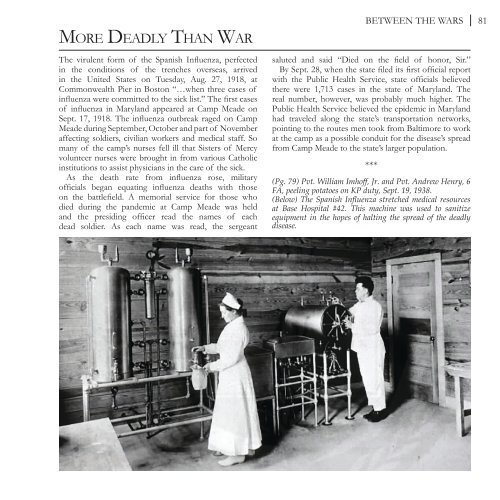Fort George G. Meade: The First 100 Years
You may know Fort George G. Meade as a cyber and intelligence hub, but did you know that the installation used to be the home of Army Tank School after World War I? Or that it housed an internment camp at the start of World War II for primarily German-American and Italian-American citizens and foreign nationals? Learn more about the fascinating history of the third largest Army base in the U.S. in terms of number of workforce in this book.
You may know Fort George G. Meade as a cyber and intelligence hub, but did you know that the installation used to be the home of Army Tank School after World War I? Or that it housed an internment camp at the start of World War II for primarily German-American and Italian-American citizens and foreign nationals? Learn more about the fascinating history of the third largest Army base in the U.S. in terms of number of workforce in this book.
You also want an ePaper? Increase the reach of your titles
YUMPU automatically turns print PDFs into web optimized ePapers that Google loves.
More Deadly Than War<br />
<strong>The</strong> virulent form of the Spanish Influenza, perfected<br />
in the conditions of the trenches overseas, arrived<br />
in the United States on Tuesday, Aug. 27, 1918, at<br />
Commonwealth Pier in Boston “…when three cases of<br />
influenza were committed to the sick list.” <strong>The</strong> first cases<br />
of influenza in Maryland appeared at Camp <strong>Meade</strong> on<br />
Sept. 17, 1918. <strong>The</strong> influenza outbreak raged on Camp<br />
<strong>Meade</strong> during September, October and part of November<br />
affecting soldiers, civilian workers and medical staff. So<br />
many of the camp’s nurses fell ill that Sisters of Mercy<br />
volunteer nurses were brought in from various Catholic<br />
institutions to assist physicians in the care of the sick.<br />
As the death rate from influenza rose, military<br />
officials began equating influenza deaths with those<br />
on the battlefield. A memorial service for those who<br />
died during the pandemic at Camp <strong>Meade</strong> was held<br />
and the presiding officer read the names of each<br />
dead soldier. As each name was read, the sergeant<br />
BETWEEN THE WARS<br />
saluted and said “Died on the field of honor, Sir.”<br />
By Sept. 28, when the state filed its first official report<br />
with the Public Health Service, state officials believed<br />
there were 1,713 cases in the state of Maryland. <strong>The</strong><br />
real number, however, was probably much higher. <strong>The</strong><br />
Public Health Service believed the epidemic in Maryland<br />
had traveled along the state’s transportation networks,<br />
pointing to the routes men took from Baltimore to work<br />
at the camp as a possible conduit for the disease’s spread<br />
from Camp <strong>Meade</strong> to the state’s larger population.<br />
***<br />
(Pg. 79) Pvt. William Imhoff, Jr. and Pvt. Andrew Henry, 6<br />
FA, peeling potatoes on KP duty, Sept. 19, 1938.<br />
(Below) <strong>The</strong> Spanish Influenza stretched medical resources<br />
at Base Hospital #42. This machine was used to sanitize<br />
equipment in the hopes of halting the spread of the deadly<br />
disease.<br />
81


